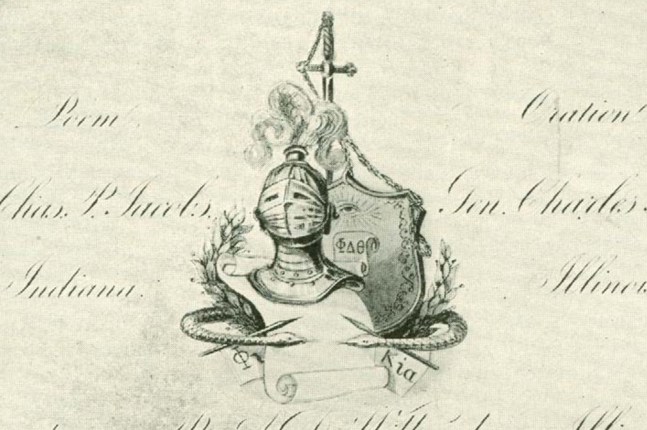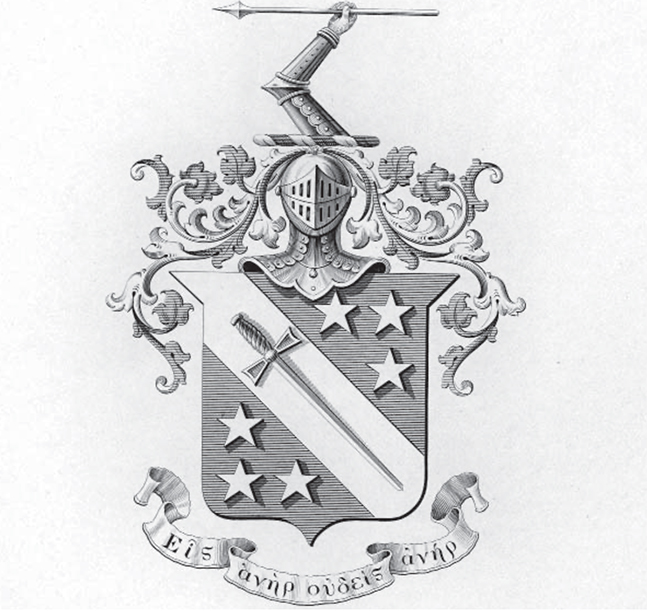
Coat of Arms Developed
1866The design of the “first” coat-of-arms was the product of a group of young men from Indiana University, Wabash College, and Miami University. Several had been soldiers of the recently-concluded War Between the States and some elements of the design were a result of the lingering military sentiment which was dominant throughout the country. J. F. Gookins, Indiana Beta, created the artwork for the engraver of a copper plate for the program at the installation of Illinois Beta at the University of Chicago on January 11 and 12, 1866.
The blazon, or formal description, of this design reads: “The design was composed of the shield, charged with the eye and scroll, the latter bearing the Phi Delta Theta letters; also, a sword attached to the shield by a chain, a larger scroll rolled so as to conceal both ends, a parchment bearing on one end Φι and on the other Κια, a helmet with closed visor, two styli, a laurel wreath and a double headed serpent.”
During the next several years, each chapter operated on their own in a nearly autonomous manner and designed similar “arms” which reflected their own schools. It seemed to become a competition between different chapters to out-do other chapters by way of these designs. There was not the centralized control by the “National Grand Chapter” that began to develop near the turn of the century. An example of one of these designs appeared in the Cornellian in 1874, where they added 1848 beneath the helmet and the Phi Delta Theta monogram behind the sword and shield.
This competition was fed by the college annuals who wanted images of the fraternities that were no longer sub rosa on their campuses. As a result there were many different designs which built off of one another. These designs were very detailed with equally detailed blazons to describe them.
Meanwhile, at the meeting of the General Council of 1888, a committee was appointed to have a plate engraved for the purpose of issuing duplicate charters to a growing number of new chapters. That plate was created by Louis Dreka, a Philadelphia stationer. It consisted of a separate plate of the “arms” and another more elaborate plate which included the arms with the name of the Fraternity on a streamer above.
At the Convention of 1889, the Fraternity decided not to elect any official stationers and chose a course which they felt would end the competition among chapters and result in a single image that would reflect recognized symbols in which the sword and shield would bind together for the use of all good Phis.
The Constitution of 1898 contained the blazon of a new coat-of-arms which reads:
- Escutcheon: azure, on a bend argent, between six mullets of the second, a sword or point downward.
- Helmet: affrontee, visor closed of the third, mantling of the first and second.
- Crest: a dexter arm embowed vambraced of the third, hand carnation hurling a javelin of the third.
- Motto: Ειs ανηρ ουδειs ανηρ
The arms described by this blazon were the result of painstaking consultation with heraldic authorities, and they conformed to the fixed requirements of heraldry. The new design was simple and avoided the over-crowded appearance of the designs created by the various chapters. The Phi Delta Theta character of the emblems is obvious to all, while to the initiated, the armorial bearing symbolizes the cardinal principles of the Fraternity.
The two Fraternity colors are displayed, the fine horizontal lines denoting azure. The two chief emblems of Phi Delta Theta are the two most prominent emblems of the arms, the sword being “charged:” a heraldic term meaning an item placed upon the shield, or rather a bend argent, which divides the azure field of the escutcheon. This charge is most appropriate as the original badge was in the form of a shield, the sword being added later. The escutcheon is of a conventional heraldic shape, instead of the badge form of shield, and the eye of the scroll bearing “Phi Delta Theta” are omitted from the new design. Instead of two javelins there is but one which is in the crest.
The features of the new arms which were not in the old arms are the six stars, the open motto, the mantling (the backdrop behind the shield, often depicted as a fabric or foliage), the wreath (twist of ribbons which the crest rests on) and the mailed arm which hurls the javelin.
This coat-of-arms was copyrighted by the Fraternity in early 1899 and based upon a preliminary engraving by R. B. Lockwood of New York and prior to acceptance and approval by the Fraternity, impressions were made from Lockwood’s plate and made the frontispiece of The Scroll, February 1899. However, the engraving was not satisfactory. The shading was not perfect, and the accent of the last word in the motto was not correct. The Lockwood did not follow directions in regard to the upper part of the visor, and without authority placed a small crescent on the front of the helmet.
Consequently, The Convention of 1902 ordered that the coat-of-arms should be engraved by some well known engraver, that the plate made by him should be the standard plate, and that chapters might have reproductions of the design made in conformity with the standard plate. The General Council decided upon the Dreka Company of Philadelphia to do the work. This company finished the plate in August 1903 and impressions from it made the frontispiece of The Scroll, October, 1903. (The frontispiece of W. B. Palmer’s The History of Phi Delta Theta was also printed from this plate.) The plate was also made larger than the one made by Lockwood.
W. B. Palmer proposed, and it was accepted by the Convention of 1900, that when the coat-of-arms was depicted in colors, the bend should be in silver, the field above and below blue, the stars silver, the sword, helmet, mail on the arm and the javelin gold, the hand flesh color, the mantling silver and blue and the motto of black letters on a white scroll.

